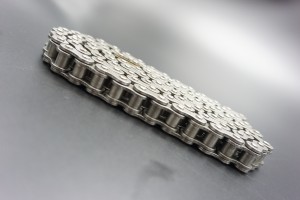Roller chains play a vital role in various industries such as manufacturing, automotive, and agriculture, where they are used to efficiently transmit power. However, one common concern among users is that roller chains stretch over time. We often hear the question: “Do roller chains stop stretching?” In this blog, we’ll delve into this topic, debunk some myths, and uncover the truth behind the phenomenon of stretching.
Learn about roller chain stretching:
To really understand the concept of roller chain stretching, it is important to understand how roller chains work. Roller chains consist of interconnecting links, each link consisting of two inner and outer plates, pins, rollers and bushings. When power is applied, the rollers engage the teeth of the sprocket, causing the links of the chain to articulate around the circumference of the sprocket. Over time, roller chain elongation, commonly referred to as stretching, may occur due to the intermeshing of the rollers and sprocket teeth.
Myth: Roller chain stretching never stops:
It is generally believed that once a roller chain starts stretching, it will last indefinitely. However, this is actually a misunderstanding. The elongation of a roller chain is usually not infinite and will reach a point where it stops stretching. The stretch of a chain is primarily affected by factors such as initial tension, load, environmental conditions, lubrication and maintenance practices.
Factors Affecting Roller Chain Stretch:
1. Initial Tension: The initial tension applied during installation plays a vital role in determining how fast the chain will stretch. A well-tensioned chain, within the manufacturer’s recommended tolerances, will experience less stretch than an under-tensioned or over-tensioned chain.
2. Loading conditions: The magnitude and nature of the load applied to the chain will increase the stretch over time. Higher loads and sudden impacts accelerate the wear process and lead to increased elongation.
3. Environmental conditions: Harsh environments, such as high temperatures, corrosive chemicals or abrasive particles, will accelerate chain wear and stretching. Regular maintenance and lubrication can help mitigate these effects.
4. Lubrication: Proper lubrication is essential to reduce friction and wear within the chain components. A well-lubricated chain experiences less stretch because the lubricant creates a protective layer that minimizes wear.
Precautions to minimize stretching:
While it is impossible to completely eliminate roller chain stretch, preventive steps can be taken to minimize its effects:
1. Regular Maintenance: Implementing a thorough maintenance program, including cleaning, inspection and lubrication, will help identify potential chain wear and address it before it causes excessive stretch.
2. Proper Tension: Ensuring the chain is installed with the correct initial tension, which is within the manufacturer’s recommended tolerances, will help extend its life and minimize stretching.
3. Lubrication: Applying the correct lubricant at the recommended intervals helps reduce friction, dissipate heat and minimize stretching from wear.
it is normal for roller chains to stretch with regular use and wear. However, contrary to popular belief, roller chains do reach a stretch stop. By understanding the influencing factors and taking proper precautions, users can significantly reduce stretch and optimize the performance and service life of roller chains in their applications.
Post time: Jul-07-2023

